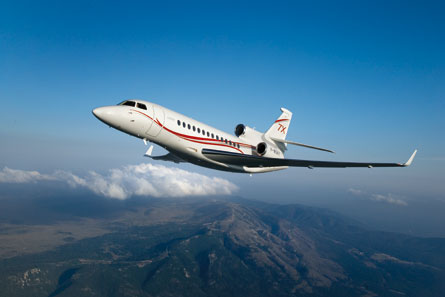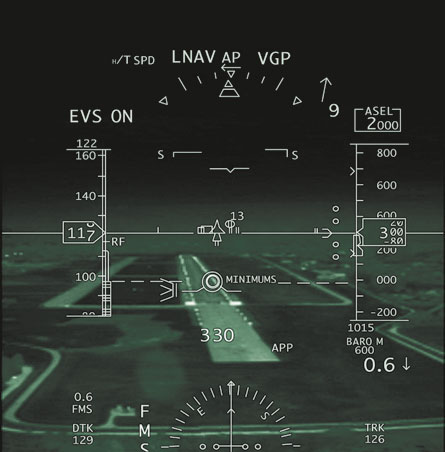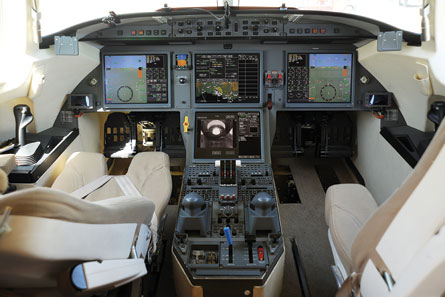In October, Dassault gained Federal Aviation Administration certification for its new "third-generation" enhanced vision system, as fitted to the Falcon 7X - and it has just won operations approval from the FAA's flight standardisation board. This follows European Aviation Safety Agency certification granted in July 2010.
In European aviation terms, an EVS is a nose-mounted camera fitted with a forward-looking infrared sensor, the image from which is projected onto a head-up display mounted in front of the left-hand pilot.
A first-generation EVS could be defined as one in which the FLIR image is projected only onto a head-down cockpit screen. In a second-generation EVS, the FLIR image is projected onto a cathode-ray type of HUD, used especially in larger business jets.
What makes the Dassault HUD/EVS "third generation" is that it uses a Rockwell Collins liquid-crystal display HUD with a 36 x 30° field of view. This significantly improves the EVS video rendering and display brightness, giving a much greater possible EVS picture contrast range.
Video processing also allows the pilot to select between two infrared energy modes - a "high mode" used to better define a terrain picture that contains variations in reflected IR energy (typically from earth, trees, water or concrete), or a "low mode" that better defines radiated energy from hot-point sources (typically from a high-intensity runway and approach lighting).
 |
|---|
©Dassault AviationThe 7X has the longest range of any Falcon business jet: 5,950nm |
A "Cal" (calibration) mode enables the pilot to wipe the EVS image to remove any thermal "streaking" that may occur during dusk/dawn conditions if the Sun passes within the camera's field of view.
To further improve the man-machine interface, Dassault has added separate pilot HUD/EVS controls for brilliance and contrast, so the left-hand seat - "pilot flying" - is now allowed almost infinite variation in setting up the HUD and EVS picture for the terrain being overflown or the ambient weather conditions/runway characteristics at landing.
My own experience of flying second-generation HUD/EVS is of it being difficult to balance HUD symbology brilliance against EVS picture contrast/brilliance, so that getting one to a satisfactory level often means visually swamping the other, and increasing brilliance often leads to fuzzing of the symbology.
The Falcon 7X's sidestick flight controller also has an "EVS instant off" switch to enable the pilot flying to remain hands-on during final approach when reverting from EVS to a fully visual image.
Other basic HUD features include HUD symbology design, de-clutter modes, and how the "flightpath vectored" parts of the HUD picture move within the HUD field of view, depending on aircraft movement.
WORK TOGETHER SEAMLESSLY
All these factors, and many more, have to work together seamlessly to make the complete HUD/EVS system a success - and for the pilot flying not to be tempted to revert to head-down displays, for example while at a critical phase of flight on approach.
The design of the HUD symbology being used in the Falcon 7X HUD/EVS is exclusive to Dassault.
It is vital to keep the right-hand seat - "pilot not flying" - in the informational and decision-making crew loop. This is done by displaying the basic EVS image, without HUD symbology overlay, on the bottom of the two central EASy head-down display screens.
This allows the remaining three EASy HDD screens, positioned at the top, to be used by the pilot not flying for standard flight, navigation, and aircraft systems monitoring functions.
Each EASy HDD screen is 10 x 14in (255 x 355mm), so the HDD/EVS-displayed image for the pilot not flying is large, very well defined and unaffected by how the pilot flying has set up his or her HUD/EVS picture brilliance or contrast.
These factors have resulted in EASA granting the Dassault 7X HUD/EVS a one-third reduction in the required published "runway visual range" to start any precision or non-precision approach.
For a Category 1 instrument landing system with a decision altitude of 200ft (61m) above threshold elevation and a required minimum runway visual range of 550m, a pilot can now start the approach if the runway visual range is reported to be 370m or more.
This equates almost exactly to a Cat 2 ILS, where the required minimum runway visual range is 350m.
At the Cat 1 decision altitude - 200ft above threshold on the barometric altimeter - the HUD/EVS pilot can continue if he or she has "EVS-aided references" as visuals in the HUD, be they EVS-derived approach lights or runway images.
At 100ft above threshold, the EVS decision altitude requires visual references to be visible without EVS assistance. In practical terms, this means the HUD/EVS Cat 1 ILS approach now has an EVS decision altitude minimum for a land/go-around decision that almost exactly equates to that of the 100ft decision altitude for a Cat 2 ILS.
The only limitation of FLIR is that it cannot "see" through cloud or dense fog. Runway visual ranges of 200m or less require Cat 3A or Cat 3B ILS approaches in aircraft equipped with specialised autoland-type capabilities.
The cost of the Falcon 7X HUD/EVS is quoted at $455,000. The elegance of the system is that it now allows the pilot flying to be almost always able to fly to a 100ft decision altitude and so each approach becomes a "single event".
It also means that the aircraft operator does not need to fit all the expensive equipment currently needed to meet Cat 2 ILS requirements - which all has to be serviceable at the start of the approach. Also, the airport does not need Cat 2 runway lighting systems and "fail active or passive" Cat 2 ILS type equipment/calibration.
NO CONFUSION OVER ROLES
For the crew, this means that, because the pilot flying/pilot not flying roles are fixed, there can be no confusion between them over who does what.
My evaluation aircraft was Falcon 7X F-WFBW, and I would fly the complete evaluation from the left-hand seat using the HUD/EVS. My safety pilots were Dassault test pilots Dominique Chenevier and Philippe Rebourg.
I was seeking answers to two questions. Could the HUD/EVS make night flying as safe and as easy as day flying when manoeuvring within a highly demanding flight/terrain environment? And secondly, could I truly use the HUD/EVS as my sole source of flight display reference without being tempted to go "head down"?
 |
|---|
©Dassault AvaitionThe EVS has gained FAA approval |
Take-off from Istres was at dusk. Two visual familiarisation circuits were followed by a medium-level transit to an ILS approach to Chambery Runway 18, before a break-off to fly "visual circuits" at night to low-overshoot Runway 36.
Chambery airport, at an elevation of 780ft, is surrounded by mountains rising to over 5,000ft within 4.8-8km (2.6-4.3nm) of the airport on either side and in a horseshoe to the south. A visual circuit manoeuvre to Runway 36 is normally prohibited except in day conditions at a minimum descent altitude of about 1,700ft and requiring visibility of more than 3,000m.
Within this terrain, I would be flying manually, in an aircraft I had flown only once before, at a completely unfamiliar airfield, in inky blackness and relying solely on visual references from the HUD/EVS.
My first impression of the basic HUD at Istres and en route to Chambery was that the symbology was immaculately designed and well behaved. It gave me everything I needed within any flight regime.
The flightpath vector and flight display immediately inspired confidence, and I never once felt I needed to go head-down to pick up additional information or reassure myself about a flight mode.
Starting from the taxi out, my eyes essentially never left the HUD for the whole flight, except when changing flight-director modes on the glareshield-mounted flight guidance panel or when occasionally viewing the basic EVS picture on the lower EASy central HDD.
Within five minutes of first take-off, I had become a HUD junkie again. Even without the EVS, the LCD HUD and the Dassault-designed symbology was superb. Compared with a conventional HUD, the LCD HUD image is like viewing a modern flatscreen HD television next to an old black-and-white set.
I instantly liked the flexibility and accuracy with which I could individually set up the background HUD/EVS brilliance and contrast to a level that suited me and the external conditions - without having to continually read just the basic HUD afterwards.
The Cal mode wipes the EVS picture for about 20s, and I felt later in the sortie that this temporary loss of EVS image was like losing my right arm, so important had the EVS become to my perception of my flightpath and my view of the external world.
TOTAL SITUATIONAL AWARENESS
During the two visual, right-hand, night circuits at Chambery, I noted my radar altimeter was showing less than 900ft above ground level over the city lights of Chambery - yet I was still fully EVS visual with the steeply rising mountainous terrain less than 1,000m off my left wing and 5km forward of my nose on the downwind, southerly leg. At all times, the HUD/EVS gave me total situational, flight and geographical awareness during any manoeuvre - in all phases of the instrument approach, the visual circuits and the low overshoots.
Recovering to Istres, I flew a localiser-only approach to low-overshoot Runway 15. I liked the way the HUD symbology automatically de-cluttered upon approach capture even though the HUD symbology always remained widely spaced.
Given the environmental conditions at Istres (dry and warm), there was little difference to be seen in the HUD/EVS between the pilot-selected "high" (reflected IR) or "low" (radiated IR) modes.
 |
|---|
©Dassault AviationThe Dassault HUD/EVS deploys a Rockwell Collins liquid-crystal display |
But training videos shown by Dassault during the pre-flight technical briefing showed clearly that the low mode has significant benefits in snowy, misty or rainy conditions where ground-reflected IR is neutral but radiated runway lighting IR predominates.
For my final, right-hand night circuit, I placed myself "hot and high" on final approach and had all the runway and approach lighting turned off.
Normally, at night, this would result in an instant go-around, but with the HUD/EVS I simply flew a "visual" steep approach pointing into the unlit runway undershoot to regain final flightpath and then landed on-speed, at the correct runway landing point, into an EVS-aided soft touchdown flare.
After leaving the aircraft on shutdown, I felt completely relaxed despite having just flown a very high-risk sortie.
It had been, without exaggeration, as safe and as easy as flying the aircraft in daytime, good-visibility conditions.
For the pilot, a third-generation HUD/EVS of this fidelity closes the safety circle, partly formed by the traffic and collision awareness system and enhanced ground proximity warning system.
Its price looks minimal when set against the cost of the aircraft itself and given the huge safety and operational benefits it can bring to any future owner/operator.
Source: Flight International























